OPERATIONAL TRIALS „IliwG,HLIGHTS OF TEST YEAR
Page 78
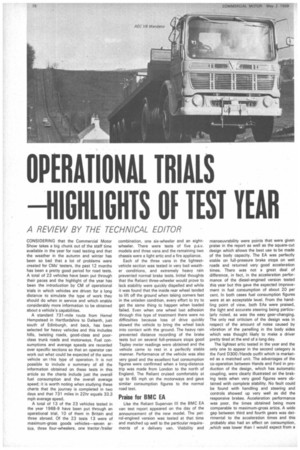
Page 79
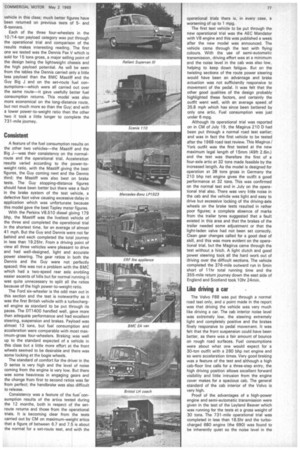
Page 80
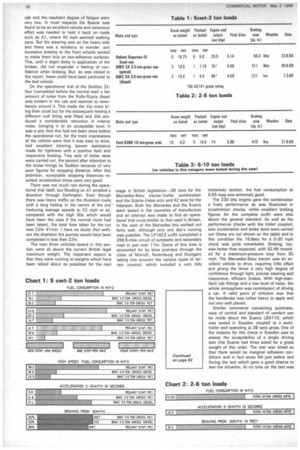
Page 84
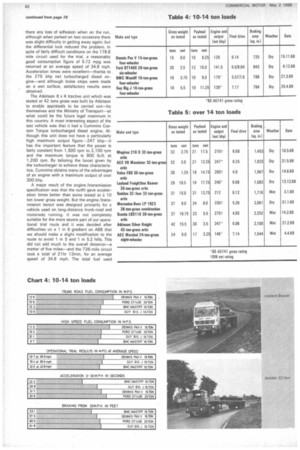
Page 85
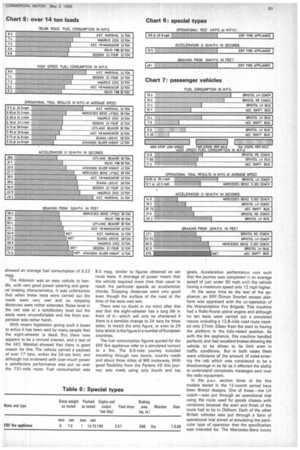
Page 86

If you've noticed an error in this article please click here to report it so we can fix it.
CONSIDERING that the Commercial Motor Show takes a big chunk out of the staff time available in the year for road testing and that the weather in the autumn and winter has been so bad that a lot of problems were created for CMs" testers, the past 12 months has been a pretty good period for road tests. A total of 23 vehicles have been put through their paces and the highlight of the year has been the introduction by CM of operational trials in which vehicles are driven for a long distance to simulate the type of work they should do when in service and which enable considerably more information to be obtained about a vehicle's capabilities.
A standard 731-mile route from Hemel Hempstead in Hertfordshire to Dalkeith, just south of Edinburgh, and back, has been selected for heavy vehicles and this includes hills, twisting roads, good-class and poorclass trunk roads and motorways. Fuel consumptions and average speeds are recorded over specific sections so that an operator can work out what could be expected of the same vehicle on this type of operation. It is not possible to include a summary of all the information obtained on these tests in this article so the charts include just the overall fuel consumption and the overall average speed; it is worth noting when studying these charts that the journey is completed in two days and that 731 miles in 22hr equals 33.3 mph average speed.
A total of 13 of the 23 vehicles tested in the year 1968-9 have been put through an operational trial, 10 of them in Britain and three abroad. Of the 23 tests 13 were of maximum-gross goods vehicles—seven artics, three four-wheelers, one tractor/trailer combination, one six-wheeler and an eightwheeler. There were tests of five p.s.v. models and three vans and the remaining two chassis were a light artic and a fire appliance.
Each of the three vans in the lightestvehicle section was tested in very bad weather conditions, and extremely heavy rain prevented normal brake tests. Initial thoughts that the Reliant three-wheeler would prove to lack stability were quickly dispelled and while it was found that the inside rear wheel tended to lift off the ground when taking corners fast in the unladen condition, every effort to try to get the same thing to happen when loaded failed. Even when one wheel lost adhesion through this type of treatment there were no difficulties because loss of drive quickly slowed the vehicle to bring the wheel back into contact with the ground. The heavy rain prevented distance recording of the brake tests but on several full-pressure stops good Tapley meter readings were obtained and the vehicle came to rest in a perfectly stable manner. Performance of the vehicle was also very good and the excellent fuel consumption figures were confirmed when a long-distance trip was made from London to the north of England. The Reliant cruised comfortably at up to 65 mph on the motorways and gave similar consumption figures to the normal road test.
Praise for BM C EA
Like the Reliant Supervan Ill the BMC EA van test report appeared on the day of the announcement of the new model. The petrol-engined version was tested at that time and matched up well to the particular requirements of a delivery van. Visibility and manoeuvrability were points that were given praise in the report as well as the square-cut design which allows the best use to be made of the body capacity. The EA was perfectly stable on full-pressure brake stops on wet roads and returned very good acceleration times. There was not a great deal of difference, in fact, in the acceleration performance of the diesel-engined version tested this year but this gave the expected improvement in fuel consumption of about 20 per cent. In both cases fuel consumption figures were at an acceptable level. From the handling point of view, both EAs were praised, the light and accurate steering being particularly noted, as was the easy gear-changing. The only real criticism of the design was in respect of the amount of noise caused by vibration of the panelling in the body sides which was thought likely to make a driver pretty tired at the end of a long day.
The lightest artic tested in the year and the only one to appear in the second category is the Ford D300 /Hands outfit which is marketed as a matched unit. The advantages of the co-operation between Hands and Ford in production of the design, which has automatic coupling, were clearly illustrated on the braking tests when very good figures were obtained with complete stability. No fault could be found with handling and steering and controls showed up very well as did the responsive brakes. Acceleration performance was poor, the times obtained being more comparable to maximum-gross artics. A wide gap between third and fourth gears was detrimental to the acceleration times and this probably also had an effect on consumption, .which was lower than I would expect from a vehicle in this class; much better figures have been returned on previous tests of 5and 6-ton oars.
Each of the three four-wheelers in the 10/14-ton payload category was put through the operational trial and comparison of the results makes interesting reading. The first one we tested was the Dennis Pax V which is sold for 15 tons gross, a major selling point of the design being the lightweight chassis and the high payload potential. As will be seen from the tables the Dennis carried only a little less payload than the BMC Mastiff and the Guy Big J and on the set-route fuel consumptions—which were all carried out over the same route—it gave usefully better fuel consumption returns. This model was also more economical on the long-distance route, but not much more so than the Guy; and with a lower power-to-weight ratio than the other two it took a little longer to complete the 731-mile journey.
Consistent
A feature of the fuel consumption results on the other two vehicles—the Mastiff and the Big J—was their consistency on the normalroute and the operational trial. Acceleration results varied according to the power-toweight ratio, with the Mastiff giving the best figures, the Guy coming next and the Dennis third; the Mastiff was also best on brake tests. The Guy stopping-distance figures should have been better but there was a fault in the brake system of the test vehicle, a defective foot valve causing excessive.delay in application which was unfortunate because this model gave the best Tapley meter figures.
With the Perkins V8.510 diesel giving 179 bhp, the Mastiff was the liveliest vehicle of the three and completed the operational trial in the shortest time, for an average of almost 41 mph. But the Guy and Dennis were not far behind and each completed the total journey in less than 19.25hr. From a driving point of view all three vehicles were pleasant to drive and had well-designed, light and accurate power steering. The gear ratios in both the Dennis and the Guy were not perfectly spaced; this was not a problem with the B MC which had a two-speed rear axle enabling easier ascents of hills but for normal running it was quite unnecessary to split all the ratios because of the high power-to-weight ratio.
The Ford six-wheeler is the odd man out in this section and the test is noteworthy as it was the first British vehicle with a turbocharged engine as standard to be put through its paces. The DT1400 handled well, gave more than adequate performance and had excellent steering, suspension and brakes. Payload was almost 13 tons, but fuel consumption and acceleration were comparable with most maximum-gross four-wheelers. Braking was well up to the standard expected of a vehicle in this class but a little more effort at the front wheels seemed to be desirable and there was some locking at the bogie wheels.
The standard of comfort for the driver in the D series is very high and the level of noise coming from the engine is very low. But there was some heaviness in engaging gears and the change from first to second ratios was far from perfect; the handbrake was also difficult to release.
Consistency was a feature of the fuel consumption results of the artics tested during the 12 months, both in respect of the set route returns and those from the operational trials. It is becoming clear from the tests carried out by CM on maximum-weight artics that a figure of between 6.7 and 7.5 is about the normal for a set-route test, and with the operational trials there is, in every case, a worsening of up to 1 mpg.
The first test vehicle to be put through the new operational trial was the AEC Mandator with V8 engine and this was published a week after the new model was announced. The vehicle came through the test with flying colours. With the use of semi-automatic transmission, driving effort was at a minimum and the noise level in the cab was also low, helping to keep down fatigue. But on the twisting sections of the route power steering would have been an advantage and brake actuation was not sufficiently responsive to movement of the pedal. It was felt that the other good qualities of the design probably highlighted these factors, and certainly the outfit went well, with an average speed of 35.8 mph which has since been bettered by only one artic. Fuel consumption was just under 6 mpg.
Although its operational trial was reported on in CM of July 19, the Magirus 210 D had been put through a normal road test earlier; and was in fact the first vehicle to be tested after the 1968 road test review. This Magirus/ York outfit was the first tested at the new maximum legal length of 15mm (49ft 2.6in.) and the test was therefore the first of a four-axle artic at 32 tons made feasible by the increased length. As the model is designed for operation at 38 tons gross in Germany the 210 bhp net engine gives the outfit a good performance at 32 tons. This was confirmed on the normal test and in July on the operational trial also. There was very little noise in the cab and the vehicle was light and easy to drive but excessive locking of the driving-axle wheels on the brake tests resulted in rather poor figures; a complete absence of marks from the trailer tyres suggested that a fault existed in this area and that the brakes of the trailer needed some adjustment or that the light-laden valve had not been set correctly. Clean gear changes called for a good deal of skill, and this was more evident on the operational trial, but the Magirus came through the test without a hitch. A light clutch and good power steering took all the hard work out of driving over the difficult sections, The vehicle completed the 376-mile outward run in 5min short of 11 hr total running time and the 355-mile return journey down the east side of England and Scotland took 10hr 24min.
Like driving a car
The Volvo F88 was put through a normal road test only, and a point made in the report was that driving the vehicle was very much like driving a car. The cab interior noise level was extremely low, the steering extremely light and completely positive and the brakes finely responsive to pedal movement. It was felt that the front suspension could have been better, as there was a fair amount of bounce on rough road surfaces. Fuel consumptions were about what one would expect for a 30-ton outfit with a 260 bhp net engine and so were acceleration times. Very good braking was a feature of the test and although a high cab-floor line calls for a three-step entry, the high driving position allows excellent forward visibility and little intrusion from the engine cover makes for a spacious cab. The general standard of the cab interior of the Volvo is very high.
Proof of the advantages of a high-power engine and semi-automatic transmission were given in the test of the Leyland Beaver which was running for the tests at a gross weight of 30 tons. The 731-mile operational trial was completed in less than 18.5hr and the turbocharged 680 engine (the 6901 was found to be inherently quiet so the noise level in the cab and the resultant degree of fatigue were very low. In most respects the Beaver was found to be an excellent vehicle and conscious effort was needed to hold it back on roads such as Al, where 40 mph seemed walking pace. But the steering was on the heavy side and there was a tendency to wander, and excessive braking at the front wheels tended to make them lock on low-adhesion surfaces. This, with a slight delay in application of the brakes, did not engender a feeling of confidence when braking. But, as was stated in the report, these could have been particular to the test vehicle.
On the operational trial of the Seddon 32: four (completed before the normal test) a fair amount of noise from the Rolls-Royce diesel was evident in the cab and seemed to reverberate around it. This made the trip more tiring than usual but for the subsequent testing a different roof lining was fitted and this produced a considerable reduction in interior noise, bringing it to an acceptable level. It was a pity that this had not been done before the operational run, for the main impressions of the vehicle were that it was easy to drive, had excellent steering (power assistance made for lightness with a positive feel) and responsive braking. Two sets of brake tests were carried out, the second after attention to the brake linings by Seddon because of very poor figures for stopping distance. After this attention, acceptable stopping distances resulted; acceleration times were very good.
There was not much rain during the operational trial itself, but flooding on Al entailed a diversion through Darlington. Even though there was heavy traffic on the diversion route with a long holdup in the centre of the city (reducing average speeds to 22 mph or so, compared with the high 30s which would have been the case if the normal route had been taken), the total time taken for the run was 2 2hr 41min. I have no doubt that without the diversion the journey would have been completed in less then 2 2hr.
The next three vehicles tested in this section were all above the current British legal maximum weight. The important aspect is that they were running at weights which have been talked about as possibles for the next stage in British legislation----38 tons for the Mercedes-Benz tractor /trailer combination and the Scania-Vabis artic and 42 tons for the Atkinson. Both the Mercedes and the Scania were tested in the countries of manufacture and an attempt was made to find an operational trial route similar to that used in Britain. In the case of the Mercedes this worked out fairly well, although only one day's running was possible. The LP192 3 outfit completed a 3 5 6.5-mile circuit of autobahn and secondary road in just over 1 1hr. Some of this time is accounted for by slow journeys through the cities of Munich, Nuremburg and Stuttgart; taking into account the various types of terrain covered, which included a very hilly motorway section, the fuel consumption at 6.65 mpg was extremely good.
The 230 bhp engine gave the combination a lively performance as was illustrated in acceleration checks, while excellent braking figures for the complete outfit were also above the general standard. As well as the performance checks with the trailer coupled, solo acceleration and brake tests were carried out (these are not shown on the table) and in this condition the 1 6.9sec for a 0-30 mph check was quite remarkable. Braking, too, was better than expected, with 52.4ft recorded for a maximum-pressure stop from 30 mph. The Mercedes-Benz tractor was an excellent vehicle to drive, requiring little effort and giving the driver a very high degree of confidence through light, precise steering and responsive, efficient brakes. With high-standard cab fittings and a low level of noise, the whole atmosphere was reminiscent of driving a car. A valid point of criticism was that the handbrake was rather heavy to apply and not very well placed.
Similar comments concerning quietness, ease of control and standard of comfort can be made about the Scania LBS1 10, which was tested in Sweden coupled to a semitrailer and operating at 38 tons gross. One of the reasons for this check in Sweden was to assess the acceptability of a single driving axle (the Scania had three axles) for a gross weight of this order. The test was timed so that there would be marginal adhesion conditions and in fact snow fell just before and during the test which gave a good chance to test the situation. At no time on the test was there any loss of adhesion when on the run, although when parked on two occasions there was slight difficulty in getting away again; but the differential lock reduced the problem. In spite of fairly difficult conditions on the 178.8 mile circuit used for the trial, a reasonably good consumption figure of 5.72 mpg was returned at an average speed of 34.8 mph. Acceleration times were excellent-thanks to the 275 bhp net turbocharged diesel engine-and although brake stops were made on a wet surface, satisfactory results were obtained.
The Atkinson 6 x 4 tractive unit which was tested at 42 tons gross was built by Atkinson to enable appraisals to be carried out-by themselves and the Ministry of Transport-at what could be the future legal maximum in this country. A most interesting aspect of the test vehicle was that it had a Cummins Custom Torque turbocharged diesel engine. Although this unit does not have a particularly high maximum output figure-247 bhp-it has the important feature that the power is fairly constant from 1,500 rpm to 2,100 rpm and the maximum torque is 900 lb.ft. at 1,200 rpm. By tailoring the boost given by the turbocharger to achieve these characteristics, Cummins obtains many of the advantages of an engine with a maximum output of over 300 bhp.
A major result of the engine /transmission specification was that the outfit gave acceleration times better than some tested at a 10 ton lower gross weight. But the engine /transmission layout was designed primarily for a vehicle used on long-distance trunk-road and motorway running. It was not completely suitable for the more severe part of our operational trial route and it was decided after difficulties on a 1 in 6 gradient on A68 that we should make a slight modification to the route to avoid 1 in 5 and 1 in 5.2 hills. This did not add much to the overall distance-a matter of five miles-and the 736-mile circuit took a total of 21hr 13min, for an average speed of 34.8 mph, The total fuel used showed an average fuel consumption of 5.23 mpg.
The Atkinson was an easy vehicle to handle, with very good power steering and general braking characteristics. It was unfortunate that when brake tests were carried out the roads were very wet and so stopping distances were rather extended. Noise level in the cab was at a satisfactory level but the seats were uncomfortable and the front suspension was rather harsh.
With recent legislation giving such a boost to artics it has been said by many people that the eight-wheeler is dead. But there now appears to be a revived interest, and a test of The AEC Marshal showed that there is good reason for this. The vehicle carried a payload of over 17 tons, within the 24-ton limit, and although not endowed with over-much power a satisfactory performance was put up over the 731-mile route. Fuel consumption was 8.5 mpg, similar to figures obtained on set route tests. A shortage of power meant that the vehicle required more time than usual to reach the particular speeds on acceleration checks. Stopping distances were very good even though the surface of the road at the time of the tests was wet.
There was no doubt in my mind after this test that the eight-wheeler has a long life in front of it--which will only be shortened if there is a sensible change to 24 tons for three axles, to match the artic figure, or even to 26 tons which is the figure in a number of European countries.
The fuel consumption figures quoted for the ERF fire-appliance refer to a simulated turnout to a fire. The 8.6-mile journey included travelling through two towns, country roads arid about three miles of M6 motorway. With good flexibility from the Perkins V8 this journey was made using only fourth and top gears. Acceleration performance was such that the journey was completed in an average speed of just under 50 mph with the vehicle having a maximum speed only 12 mph higher.
At the same time as the test of the appliance, an ERF /Simon Snorkel escape platform was appraised with the co-operation of the Warwickshire Fire Brigade. This machine had a Rolls-Royce petrol engine and although no set tests were carried out a simulated rescue including a 12.8-mile road route needed only 27min 33sec from the start to having the platform in the fully-raised position. As with the fire appliance, this machine handled perfectly and had excellent brakes allowing the vehicle to be driven to its limit even in traffic conditions. But in both cases there were criticisms of the amount of noise entering the cab which was considered to be a disadvantage in so far as it affected the ability to understand completely messages sent over the radio equipment.
In the p.s.v. section three of the five models tested in the 12-month period have been Bristol designs. One of these—the LH coach—was put through an operational trial using the route used for goods chassis with variations because the start and finish of the route had to be in Oldham. Each of the other British vehicles was put through a form of operational trial aimed at simulating the particular type of operation that the specification was intended for. The Mercedes-Benz luxury coach was tested in Germany over the same 3 5 6.5-mile circuit of autobahn and country road used for the tractor /trailer combination already referred to.
The Bristol RE tested was lent for the purpose by Western National Omnibus Co. Ltd. arid had a Gardner 6HLX driving through a semi-automatic gearbox. The 45-seater was designed for express-coach-service use and as well as a normal road test, an operational trial which consisted of a typical service route was completed. Very good figures were obtained for fuel consumption on normal testing and on the 243-mile-long test the figure was 1 4.2 5 mpg with average speeds on the out-andreturn journey from Bristol to London ranging between 35.7 mph on the open road to 20.3 mph in London traffic. Although not power assisted, steering of the RE was light and precise and the ride characteristics given by the suspension—leaf springs–were good. But driver comfort was spoilt by an uncomfortable seat.
Two relatively short operational trials were carried out on the AEC Swift 49-seat single deck bus. The first was a "limited-stop" route from Aldenham in Hertfordshire to Liverpool Street station in London and the journey was completed at an average speed of 20 mph with a fuel consumption of 9.74 mpg. The second trial was along the London Transport No. 9 route from Liverpool St. to Mortlake garage and on this journey the average speed was 10.3 mpg with the fuel consumption 7.35 mpg. These figures served to confirm the results of the normal fuel consumption checks which, of course, are over a six-mile route with six-stops per mile and two-stops per mile.
Very wet weather prevented proper brake tests but the system had a smooth and pro gressive action and gave satisfactory Tapley meter readings. Use of a semi-automatic transmission meant good acceleration times as well as giving the main advantage of reducing the work of the driver and allowing him to pay all his attention to driving the vehicle through congested areas. This vehicle also had leafspring suspension which gave an excellent ride and the un-assisted steering layout was also light and positive.
As I have already mentioned the Bristol LH coach was taken over the long-distance oper ational trial route and with the extra journeys entailed in collecting the vehicle from Oldham and returning it there, a total of 849 miles was covered. The total time that the vehicle was on the road was 2 lhr 3 5min which equals 39.4 mph and the fuel consumption was good at 16.05 mpg. Fuel consumption was generally very good the minimum figure being 1 2.8 5 mpg on the very severe part of the journey. Very good braking results were obtained and acceleration times were up to standard for a coach weighing a total of 10 tons 1 2.2 5cwt. Although the clutch and gear change were heavy and the accelerator pedal position caused an ache in the right leg there were compensating advantages of excellent visibility and steering. The Bristol had a Leyland 0.400 engine driving through a five-speed synchromesh gearbox.
A similar specification but with Perkins 6.354 engine applies to the second Bristol LH tested and another difference of importance was the body which was a service-bus type with 45 seats. On this vehicle only a normal test was completed. Again brake results were very good and acceleration times and fuel consumptions well up to standard. Like the coach, the general handling of the service LH was excellent and modifications made to the clutch and gearchange mechanisms since the earlier LH test reduced the effort but there was still some difficulty in engaging low gears when the vehicle was stationary. Clutch effort was reduced but still felt to be rather high for a vehicle in busy traffic.
The final p.s.v. to appear in this section— the Mercedes-Benz 0.302 luxury coach—had a 230 bhp diesel. With a gross weight of 14 tons 4.5cwt there was naturally a lively performance and acceleration times obtained were excellent. The brakes felt good for nor mal driving but stopping distances were greater than expected and there was a possi bility that the brakes needed adjustment. One of the main features of the test was the extremely low level of noise inside the body both from mechanical sources and from other traffic and the coach was light to handle. The Mercedes-Benz made good progress along the autobahn on the operational trial with little slowing down even for the severe hills on one part of the route; on the winding section of second-class roads power steering and excellent visibility helped in the maintenance of a very good average speed. The overall figures were 40.5 mph at a fuel consumption of 12.1 mpg and this compared with about 13 or 14 mpg returned on high-speed running. Acceleration times were comparable with those of medium-weight vans and from both the driver's and passenger's angle, the 0.302 was found to be a very pleasant vehicle to travel in with air suspension ironing out irregularities and allowing little roll or pitching.
And that is that. A very interesting year for road tests and it is hoped the interest will be repeated in the coming 12 months. A lot depends on the vehicles offered for test and for that matter on the design of new vehicles introduced during the next year. It will be noticed that names prominent in the British manufacturing industry are missing from the list of vehicles tested and this is not through want of trying to get examples of their wares. For one thing, I would be delighted to get an artic with Gardner 6LX or 6LYB engine for test over the operational trial route but have been unsuccessful so far.




















































































































































































































